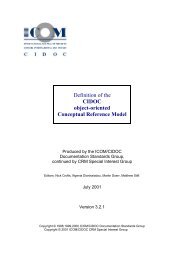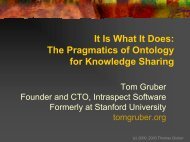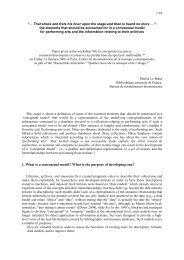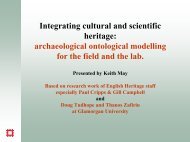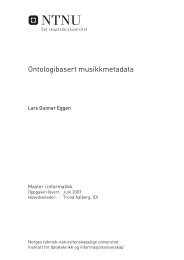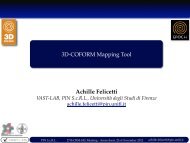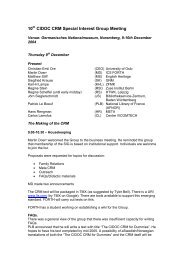documenting cultural heritage in small museums - The CIDOC CRM
documenting cultural heritage in small museums - The CIDOC CRM
documenting cultural heritage in small museums - The CIDOC CRM
You also want an ePaper? Increase the reach of your titles
YUMPU automatically turns print PDFs into web optimized ePapers that Google loves.
E62 Str<strong>in</strong>g) and the “P2 has type” (E1 <strong>CRM</strong> Entity.P2 has type (is type of): E55 Type) of the<strong>CIDOC</strong> <strong>CRM</strong>.In a way, all data may be regarded as epistemological once they appear <strong>in</strong> a document: <strong>The</strong>yare statements of what has been understood. It is only the subject matter, the mean<strong>in</strong>g ofsome of the statements that consists of possible states of affairs of the th<strong>in</strong>gs under<strong>in</strong>vestigation, the ontological view. <strong>The</strong>refore, there are always two k<strong>in</strong>ds of mapp<strong>in</strong>g: One tosee the document as a document and as statements how the knowledge was acquired, andanother based on its propositions about reality. For <strong>in</strong>formation <strong>in</strong>tegration, we need thelatter. For understand<strong>in</strong>g what to believe, we need the former. In order to turn an ontology<strong>in</strong>to a document format, we have to add the epistemological part. In order to <strong>in</strong>tegrate<strong>in</strong>formation, we have to get rid of it. An <strong>in</strong>tegrated <strong>in</strong>formation environment must preserveboth views. <strong>The</strong> epistemological has priority: if it lost, we cannot <strong>in</strong>terpret knowledge. Wecan reconstruct the ontological view from it, if it is suitably organized.Most data elements <strong>in</strong> our format are based on repetitions of a basic event pattern. Thispattern is based on the idea that history is represented by th<strong>in</strong>gs, people and ideas meet<strong>in</strong>g <strong>in</strong>space and time. <strong>CIDOC</strong> <strong>CRM</strong> focuses on event model<strong>in</strong>g <strong>in</strong> order to describe <strong>cultural</strong>materials and scientific observations. <strong>The</strong> event pattern is a strong mechanism [4], [5] for<strong>in</strong>tegrat<strong>in</strong>g heterogeneous complementary <strong>in</strong>formation and an advantage of its use is that allthe data elements follow<strong>in</strong>g this pattern can directly be mapped to the <strong>CIDOC</strong> <strong>CRM</strong>.<strong>The</strong> data model, which realizes the event pattern, <strong>in</strong>cludes the follow<strong>in</strong>g basic elements(mapp<strong>in</strong>g to the <strong>CRM</strong> <strong>in</strong> parentheses):(i) event ID (<strong>CIDOC</strong> <strong>CRM</strong> E5 Event:P1 is identified by :E41 Appellation),(ii) event type (<strong>CIDOC</strong> <strong>CRM</strong> E5 Event:P2 has type: E55 Type)(iii) event name (<strong>CIDOC</strong> <strong>CRM</strong> E5 Event:P2 has type: E55 Type),(iv) event date, (<strong>CIDOC</strong> <strong>CRM</strong> E5 Event: P4 has time-span:E52 Time-Span:P82 atsome time with<strong>in</strong>: E61 Time Primitive)(v) event place (<strong>CIDOC</strong> <strong>CRM</strong> E5 Event:P7 took place at :E53 Place),(vi) participants and their role <strong>in</strong> the event (persons, organizations, objects etc)(<strong>CIDOC</strong> <strong>CRM</strong> E5 Event:P12 occurred <strong>in</strong> the presence of: E39 Actor/ E70 Stuff),(vii) event description (<strong>CIDOC</strong> <strong>CRM</strong> E5 Event:P3 has note: E62 Str<strong>in</strong>g),(viii) event scope (<strong>CIDOC</strong> <strong>CRM</strong> E7 Activity: P21 had general purpose: E55 Type), (ix)method or technique (<strong>CIDOC</strong> <strong>CRM</strong> E5 Event: P12 occurred <strong>in</strong> the presence of:4



